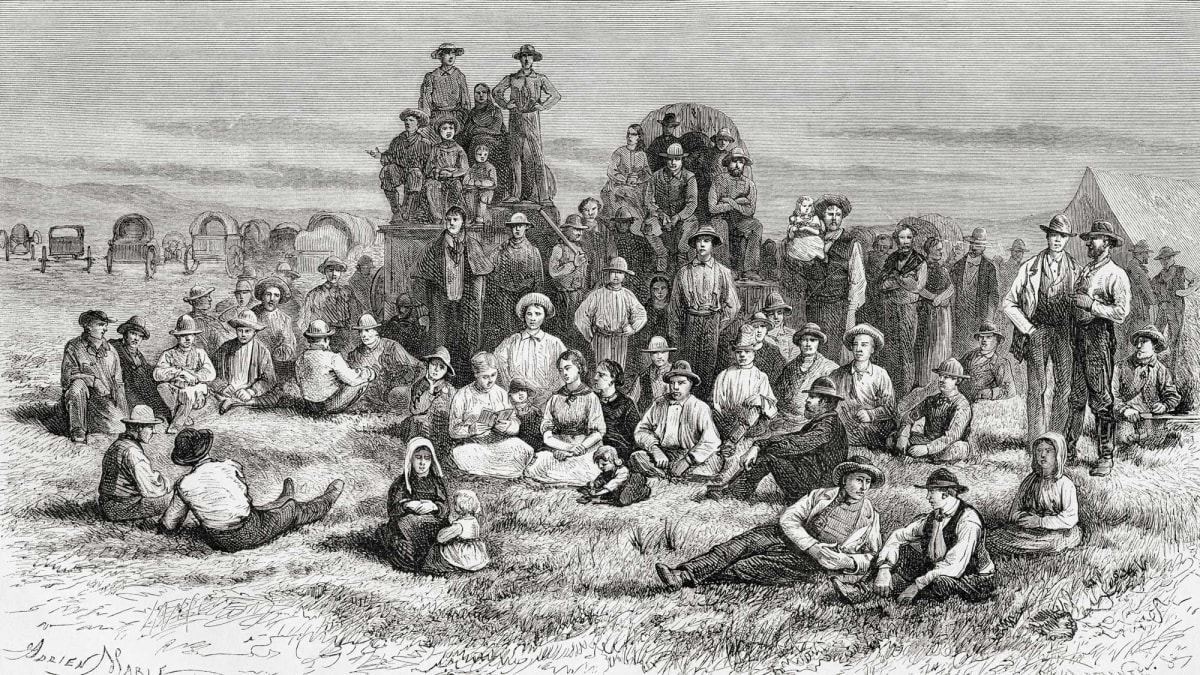
William Hyde's Church train with 62 ox-drawn wagons left Wyoming, Nebraska Territory, on August 9. Wyoming was a Missouri river port founded in 1855 and used as the principal outfitting place by Mormon companies from 1864 to 1866. It was located 44 miles south of Omaha and 6 miles north of Nebraska City. Mormons were attracted to the port city of Wyoming because of its expansive staging ground and distance from Nebraska City. It was just far enough away from the rough elements and lures of Nebraska City, yet close enough that they could easily connect with the Nebraska City-Fort Kearny Cutoff. This cutoff was established about 1860 by military freight contractors and Nebraska City businessmen. It was the shortest route from the Missouri River to Fort Kearny and became a secondary route of the Oregon Trail. It ran 169 miles directly west and shortened the distance from the old Ox-Bow Trail by about 50 miles.
Most of the 375 people in Hyde's company were Perpetual Emigrating Fund emigrants. Because of Indian troubles, Church officials instructed the party not to go beyond Salt Creek until Warren S. Snow's company caught up with them; then the two companies were to travel together. On August 30 they reached Fort Kearny, where their numbers were bolstered with others for added protection. The army reserved grazing rights at Fort Kearny, and companies weren't permitted to camp within a mile of the fort. Beyond the fort the train passed abandoned ranches and way stations and sometimes met travelers fleeing eastward. Rumors about Indians made them edgy. At one time, 500 Indians were rumored to be within a mile of the company, but no one reported actually seeing them. Although small groups of Indians did visit the train, they seemed contented with the few gifts doled out by some of the travelers. Traveling on the south side of the South Platte River, they reached Julesburg on September 12. At this place they sent a telegraph to Salt Lake reporting that many of the cattle in Hyde's and Snow's companies had a hoof ailment and requesting that 50 fresh yoke of oxen be sent to help. Within days fresh oxen and teamsters were assembled in the valley and sent east to assist them.
Julesburg was the site of a French trading post and strategically positioned at the junction point of the Upper California Crossing on the South Platte. Here they forded the South Platte and followed a new route up Lodgepole Creek. This route took them about 70 miles south of Fort Laramie through the Black Hills (present-day Laramie Mountains). They decided to take this route because feed and water were reported to be more plentiful than on the usual route via Fort Laramie. The new route took them all the way to present-day Laramie, Wyoming. Here they joined with and followed the Overland Stage Road to where it joined with the Oregon Trail near Ham's Fork. Hunters were sent out after game to augment their short rations. The company reached Ham's Fork on October 16 and arrived on a cold day in Salt Lake on October 26. Some members of the company traveled south from Echo Canyon to Heber Valley and others went down Provo Canyon. An estimated 47 people died in this late-arriving company. This was one of the largest death tolls among Mormon wagon companies.Members of the company arrived in the Salt Lake Valley from 26-30 October 1864. According to the Salt Lake Daily Telegraph, the company arrived with 60 wagons.